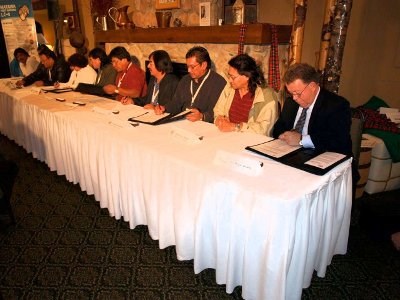A mining conference took place at the Travelodge Hotel Airlane, an initiative of the Northwestern Ontario Associated Chambers of Commerce (NOACC) and the Ministry of Northern Development and Mines (MNDM).
Ian McCormack, Co-Chair of the conference, stated, "We wanted to create a learning opportunity for NOACC members as well as people in the mining and business community."
"We felt that First Nation communities and individuals should have and can have opportunities in that industry."
NOACC's goal was to present "strategic perspectives" rather debate issues.
Chris Hodgson, president of the Ontario Mining Association, gave the keynote address and pointed out that the Toronto Stock Exchange is the mine financing capital of the world, having raised 35 per cent of the total world equity capital in 2007. It is also home to 57 per cent of the world's listed mining companies.
Hodgson set the tone of the conference, enumerating the challenges facing the industry, and suggesting reasons for optimism. The reality today, he said, includes the uncertain state of the current commodity markets, and fact that so many mining companies operate on a global scale, and invest only where they are welcome. However, "Strong demand from growing nations will keep metal prices healthy for years to come."
One of the challenges is growing the industry's workforce. "The group that will solve our problem," Hodgson said, "is women."
Women represent 13 per cent of the industry's workforce, but the industry needs at least 25 per cent representation. "People think of workers at the face of the rock [in a mine]. It's an image problem." He suggested there are many other opportunities in mining.
On Friday, two representatives of First Nations (FNs) addressed the conference. Scott Jacob, Chief of Webequie FN, opened by saying, "We want a share of the experience of intensive exploration activity within our own community."
He envisaged partnerships with the private sector. "The parties must share," he said, "the same vision, a vision of economic prosperity, that is beneficial to both parties."
Chief Jacob's community is located in the vicinity of the so-called Ring of Fire in the James Bay Lowland, also known as the McFauld's Lake area, where approximately 40 juniors are exploring for base metals and diamonds.
"That comprises about 2.5 million hectares of prime traditional lands between First Nations in the area," said Jacob.
Jacob outlined the many ways in which his community is participating in the mining exploration, but added, "In spite of many meetings, time and expenses, negotiations have not been satisfactory."
In his own presentation, Terry Waboose, the Deputy Grand Chief of Nishnawbe Aski Nation (NAN) emphasized the responsibilities of both government and the mining sector to nurture relationships. The representative of communities in James Bay Treaty 9, and the Ontario sector of Treaty 5, which also embraces Manitoba said FNs have a direct government-to-government relationship with the Crown. "The system needs to get right," Waboose said, "before we can attract real investment opportunities." NAN believes in the "sustainability approach" and in benefits to FNs.
FNs are usually quite willing to enter into exploration agreements with the private sector which detail such things as benefits, mitigation of impacts, and levels of participation, he said. However, these business agreements do not excuse the Crown from fulfilling its duty to consult. The Crown must protect and accommodate Aboriginal rights.
Ian McCormack spoke about the role of his company, Wardrop Engineering Inc. McCormack, general manager, Thunder Bay Operations, stated, "When the world thinks of mining, they think of Canada first."
However, he expects the next 12 months as likely "very painful", but it would improve, although it may take from six to eight months to feel the difference.
"Our clients don't base their project decisions on the daily up's and down's of the market," he said. Wardrop recommends to their clients that they make long-term commitments and "lock up their resources" as they weather the slump.
A fellow presenter, Dr. Christine Kaszycki, stressed the good news in the mining sector in recent years. Kaszycki, Assistant Deputy Minister with the Mines and Minerals Division of MNDM, used figures from 2007. She cited mineral production of $10.7 billion, $1.1 of that in Northwestern Ontario (NWO). The direct employment figure was 15,000, with 2,500 of that in NWO. Expenditures in exploration were $502 million, with $190 in NWO. Currently, there are some 800 exploration projects in Ontario, 350 of those in NWO.
Investment money is not flowing as before to the higher risk sector, i.e., the juniors. She asserted her faith in the long-term soundness of the industry, and referred to recent steps her Ministry is taking, such as modernization of the Mining Act.
A number of mining industry representatives discussed their companies' roles. Among them, Abraham Drost, president and CEO of Skybridge Development Corp., stressed the important role of junior exploration companies. The highlight of his presentation was a listing of juniors with offices in Thunder Bay, a total of 79.
Andrew Baumen, Technical Service Manager, described Hemlo Mines (near Marathon) as a joint venture with Barrick Gold Corp. and Teck Cominco. They employ 600 people in two underground mines and one open pit operation, producing 260,000 ounces of gold per year. They spend millions on goods & services per year, 40 per cent of that locally.
Baumen's presentation suggested to the audience the kind of prosperity that may visit other communities if any of the 79 juniors operating out of Thunder Bay achieve a resounding success.
Co-Chair Barry Streib envisaged a series of annual conferences for the future. Streib, president of NOACC, said, "In our next phase, I'd like to see a more global perspective." This phase would involve invitations to the mining sector nationally as well as internationally. He stated that this conference, having 150 registered delegates, had met its attendance target.




